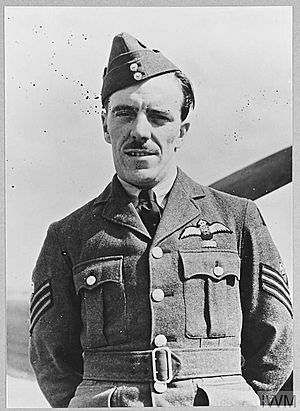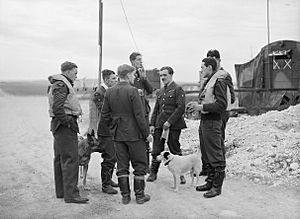Harry Steere facts for kids
Quick facts for kids
Harry Steere
|
|
|---|---|

Steere, September 1940
|
|
| Born | 7 February 1914 Wallasey, United Kingdom |
| Died | 9 June 1944 (aged 30) near Orgères, France |
| Buried |
St. Erblon Cemetery, France
|
| Allegiance | United Kingdom |
| Service/ |
Royal Air Force |
| Years of service | 1930–1944 † |
| Rank | Flight Lieutenant |
| Unit | No. 19 Squadron No. 627 Squadron |
| Battles/wars | Second World War |
| Awards | Distinguished Flying Cross Distinguished Flying Medal |
Harry Steere (7 February 1914 – 9 June 1944) was a brave British pilot. He was known as a "flying ace" because he shot down at least eleven enemy aircraft. He served in the Royal Air Force (RAF) during the Second World War.
Steere was born in Wallasey, England. He joined the RAF in 1930 as an apprentice. After training, he became a pilot and joined No. 19 Squadron. He achieved many victories during the war, including during the Dunkirk evacuation and the Battle of Britain. He was awarded the Distinguished Flying Medal and, later, the Distinguished Flying Cross. Harry Steere was killed in action in France in 1944.
Contents
Early Life and RAF Training
Harry Steere was born on 7 February 1914 in Wallasey, Cheshire. His father was a master mariner, a captain of a ship. Harry went to Manor Road Council School and then to Oldershaw Grammar School on a scholarship.
When he was 16, Harry joined the Royal Air Force (RAF). He trained to become a metal rigger, which meant he worked on the metal parts of aircraft. He finished this training in August 1933.
In 1935, Steere decided he wanted to fly. He volunteered for pilot training and earned his pilot's wings in August 1936. By 1938, he was a flight sergeant serving with No. 19 Squadron. His squadron was based at Duxford. It was the first RAF unit to fly the famous Supermarine Spitfire fighter.
Harry Steere in World War II
When the Second World War began, No. 19 Squadron mostly flew patrols to protect ships. They didn't see much fighting at first. On 11 May 1940, Steere and two other pilots worked together to destroy a Junkers Ju 88 bomber. This was the squadron's first victory of the war.
Dunkirk Evacuation Missions
In late May 1940, No. 19 Squadron helped protect the soldiers being evacuated from Dunkirk. This huge rescue mission was called Operation Dynamo. On 26 May, Steere shot down a Junkers Ju 87 dive bomber over Dunkirk. The next day, he shared in destroying a Dornier Do 17 bomber in the same area.
On 28 May, he destroyed a Messerschmitt Bf 109 fighter, again over Dunkirk. On 1 June, he shot down another Do 17. Earlier that day, he had also helped destroy a Bf 109 north of Dunkirk. For his bravery and success over Dunkirk, Harry Steere was awarded the Distinguished Flying Medal.
Battle of Britain Flights
After Dunkirk, No. 19 Squadron tried out Spitfires with cannons. These cannons often didn't work well, which caused problems during the early parts of the Battle of Britain. Steere flew a Spitfire with regular machine guns. On 19 August, he helped destroy a Messerschmitt Bf 110 heavy fighter.
By September, the squadron was back to using machine-gun equipped Spitfires. They flew regularly as part of the Duxford Wing. On 9 September, Steere probably destroyed a Bf 110 south of London. On 15 September, known as Battle of Britain Day, he probably destroyed a Bf 109 and also destroyed a Do 17 over London. Three days later, he helped shoot down a Heinkel He 111 bomber and a Ju 88 over the Thames Estuary.
On 27 September, Steere destroyed a Bf 109 near Deal. The fighting started to slow down, but No. 19 Squadron still met enemy planes. On 28 November, Steere shot down a Bf 109 east of Ramsgate. This was his last aerial victory.
Later War Service and Final Mission
In December 1940, Steere went to Upavon for an instructor's course. His brother, Jack Steere, was also in the RAF and happened to be there at the same time. Harry then became an instructor at No. 8 Flying Training School in Montrose.
He became a pilot officer in June 1941 and a flying officer in April 1942. By November 1943, Steere was a flight lieutenant. He returned to active flying with Bomber Command, joining No. 627 Squadron. His new unit, based at Oakington, flew de Havilland Mosquito aircraft and was part of the Pathfinder Force. This group helped mark targets for other bombers.
On 9 June 1944, Steere and his navigator, Flying Officer K. Gale, were attacking railway lines in Rennes, France. Their Mosquito plane crashed near Orgères, and both men died. After his death, Harry Steere was awarded the Distinguished Flying Cross.
Harry Steere was survived by his wife and son. He was buried at St. Erblon Cemetery in France. By the time he died, he was credited with shooting down eleven German aircraft. He had shared five of these victories with other pilots, and two were listed as "probably destroyed."


